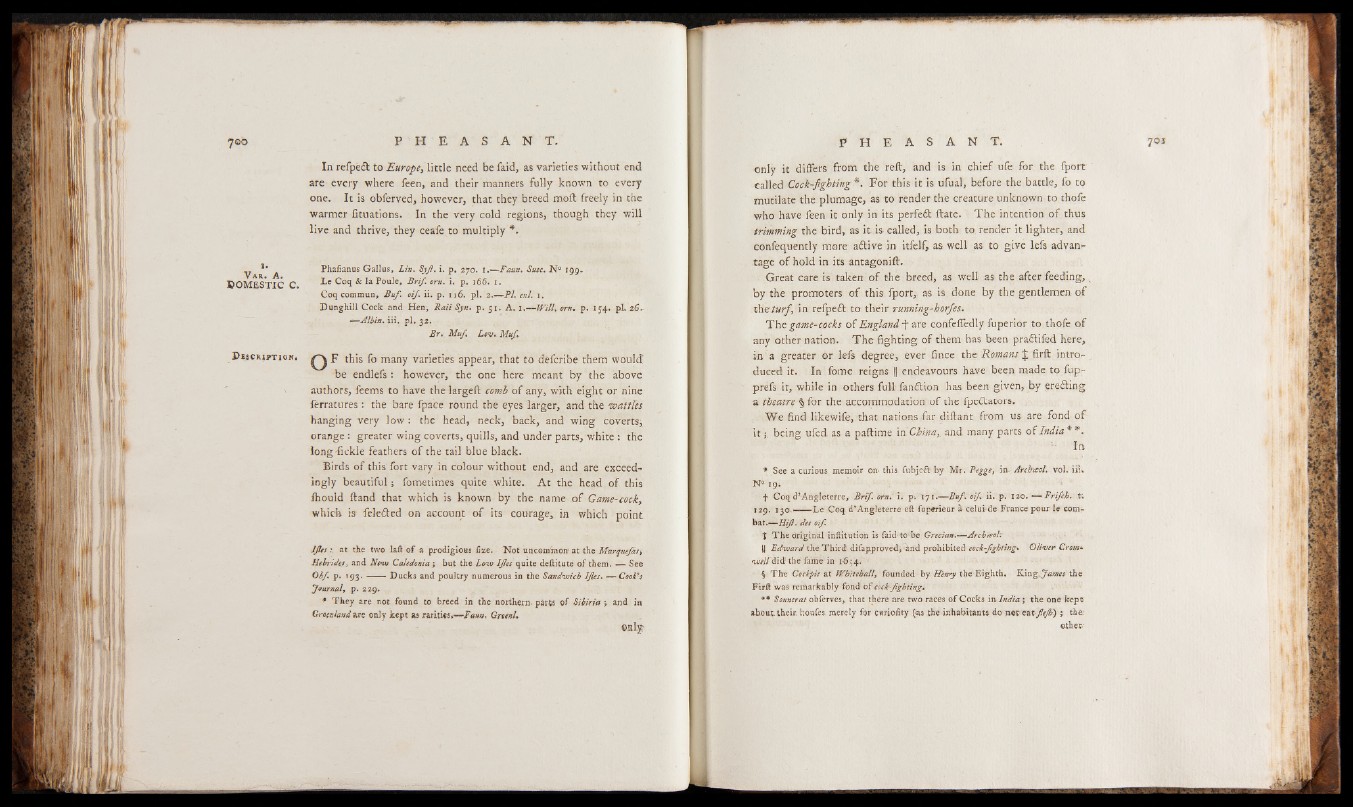
In refpeft to Europe, little need be faid, as varieties without end
are every where feen, and their manners fully known to every
one. It is obferved, however, that they breed moft freely in the
warmer fituations. In the very cold regions, though they will
live and thrive, they ceafe to multiply * .
1.
V ar. A.
DOMESTIC C.
Phafianus Gall us, Lin. Syfl. i. p. 270. 1.—Faun. Suec. -N0 199.
Le Coq & la Poule, Brif. orn. i. p. 166. 1.
Coq coalman, Buf. oif. ii. p. 116. pi. 2.—-PI. enl. 1.
Dunghill Cock and Hen, Rati Syn. p. 51. A. 1.— Will. orn. p. 154. pi. 26*
—Alhin. iii. pi. 32.
Br. Muf Lev. Muf.
D escription. Q F this fo many varieties appear, that to defcribe them would'
be endlefs: however, the one here meant by the above
authors, feems to have the largeft comb of any, with eight or nine
ferratures : the bare fpace round the eyes larger, and the wattles
hanging very low : the head, neck, back, and wing coverts,
orange: greater wing coverts, quills, and under parts, white : the
long -fickle feathers of the tail blue black.
Birds of this fort vary in colour without end, and are exceedingly
beautiful 5 fometimes quite white. At the head of this
fhould ftand that which is known by the name of Game-cock,
which is felefted on account of its courage, in which point
JJlts at the two laft of a prodigious lire. Not uncommon at the Marqutfdn
Hebrides, and New Caledonia ; but the Low IJles quite deliitute of them. — See
ObJ. p. 193.----- Ducks and poultry numerous in the Sandwich IJtes. — Cook's
journal, p. 229.
* They are not found to breed in the northern, parts of Sibiria ; and in
Cropland are only kept as rarities.—/«»», Green!.
CnLy
only it differs from the reft, and is in chief ufe for the fport
called Cock-fighting *. For this it is ufual, before the battle, fo to
mutilate the plumage, as to render the creature unknown to thofe
who have feen it only in its perfeft ftate. The intention of thus
trimming the bird, as it- is- called, is both to render it lighter, and
confequently more aftive in itfelf, as well as to give lefs advantage
of hold in its antagonift.
Great care is taken of the breed, as well as the after feeding,
by the promoters of this fport, as is done by the gentlemen of
the turf, in refpeft to their running-borfes.
The game-cocks of England ft are confeflèdly fuperior to thofe of
any other nation. The fighting of them has been pra&ifed here,
in'a greater or lefs degree, ever fince the Romans \ firft introduced
it. In fome reigns ||- endeavours have been made to fup-
prefs it, while in others full fanftion has been given, by eredting
a theatre % for the accommodation of the fpedlators.
We find likewife, that nations far diftant from us are fond of
i tbeing ufed as a paftime in China,, and many parts of India * *.
In
* See a curious memoir on- this fubjefte by Mr. Ptgge, in Archaol. vol. iik
N° 19.
•J- Coq cPAngleterre, Brif. orn. i. p. 171.— Buf. oif n. p. 120. — Frifch. t;
129. 130..---- Le Coq d’Angleterre eft fuptfrieur a celubde France pour U com*
bat.—-Hifi. des oif.
t The Original inftitution is faid to-be Grecian.—Archaol:
(J Edward the Third' disapproved, arid prohibited cock-fghting% Oliver Grom*
well'did: the fame in 1-654.
§ The Cockpit at Whitehall, founded by Henry the Eighth. King .James the
Firft was remarkably fond Oï cock-fighting.
** Sonnerat obferves, that there are two races of Cocks in India; the one kept?
about, their, houfes. merely for curiofity («as the inhabitants do net e%tfiejh)j the;
ether.'